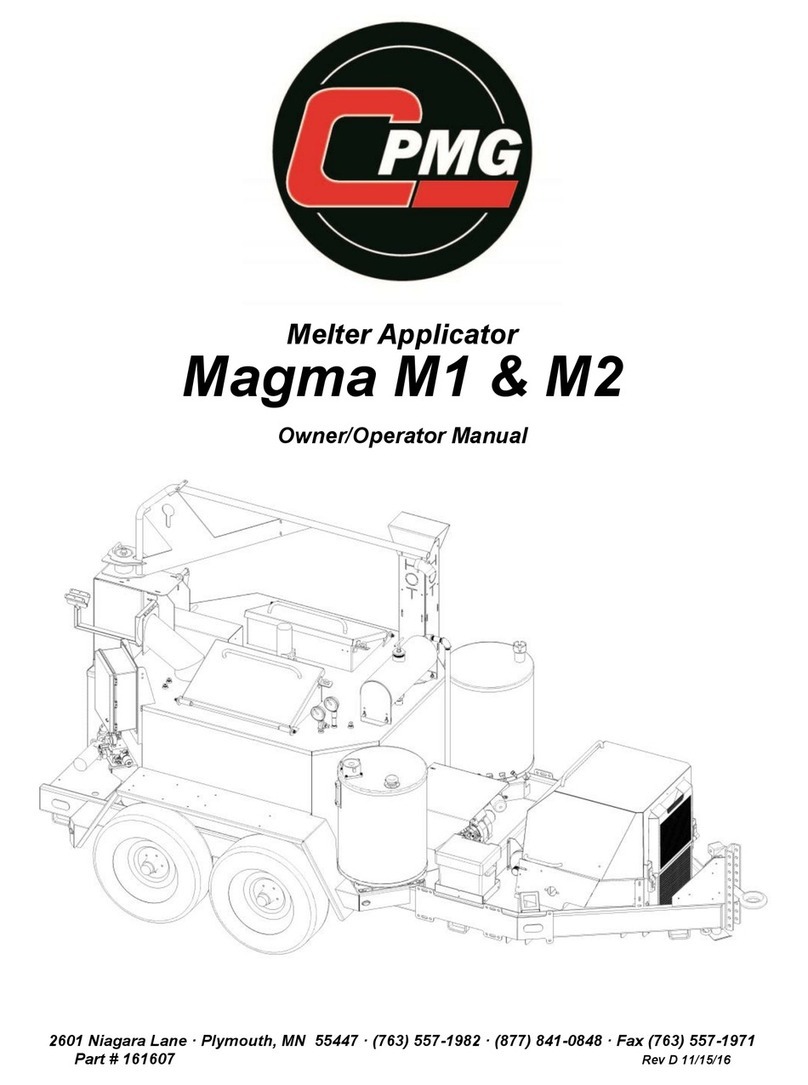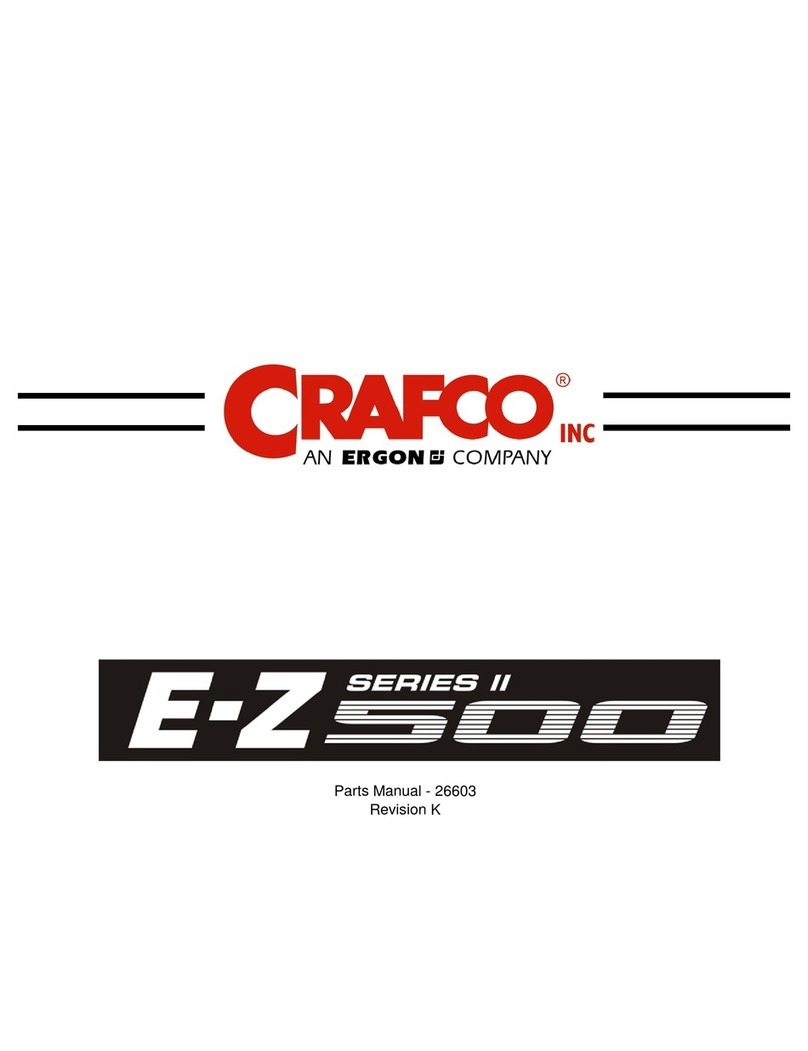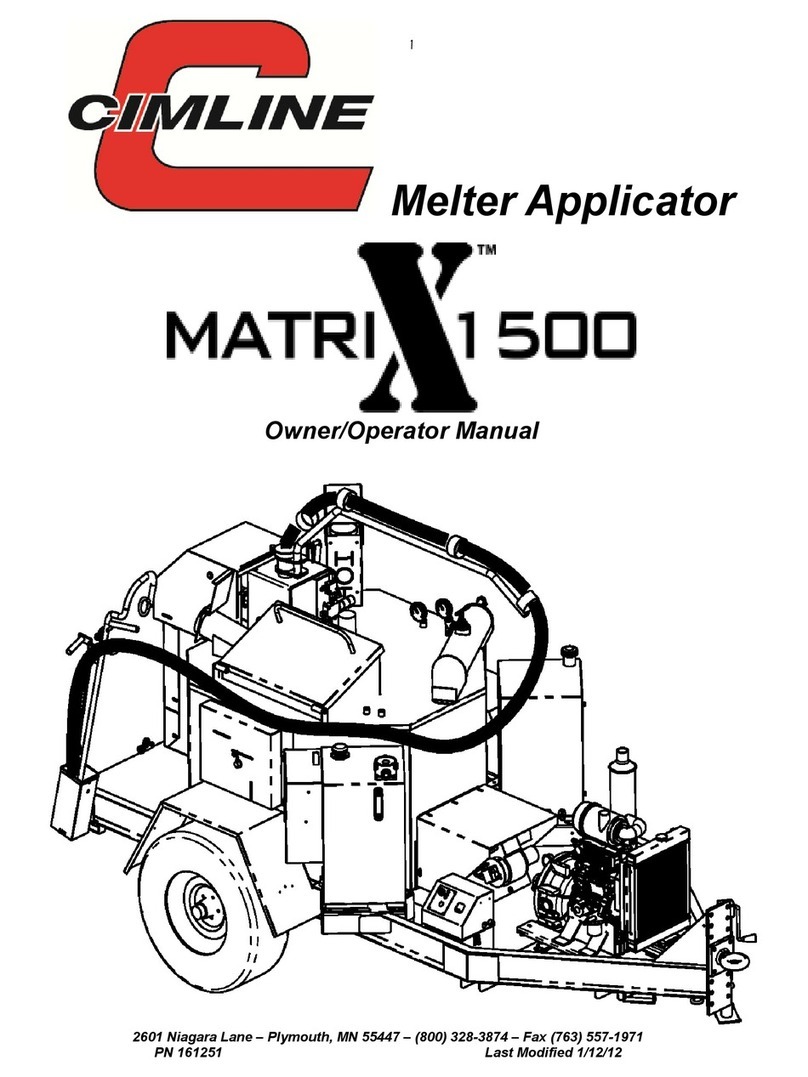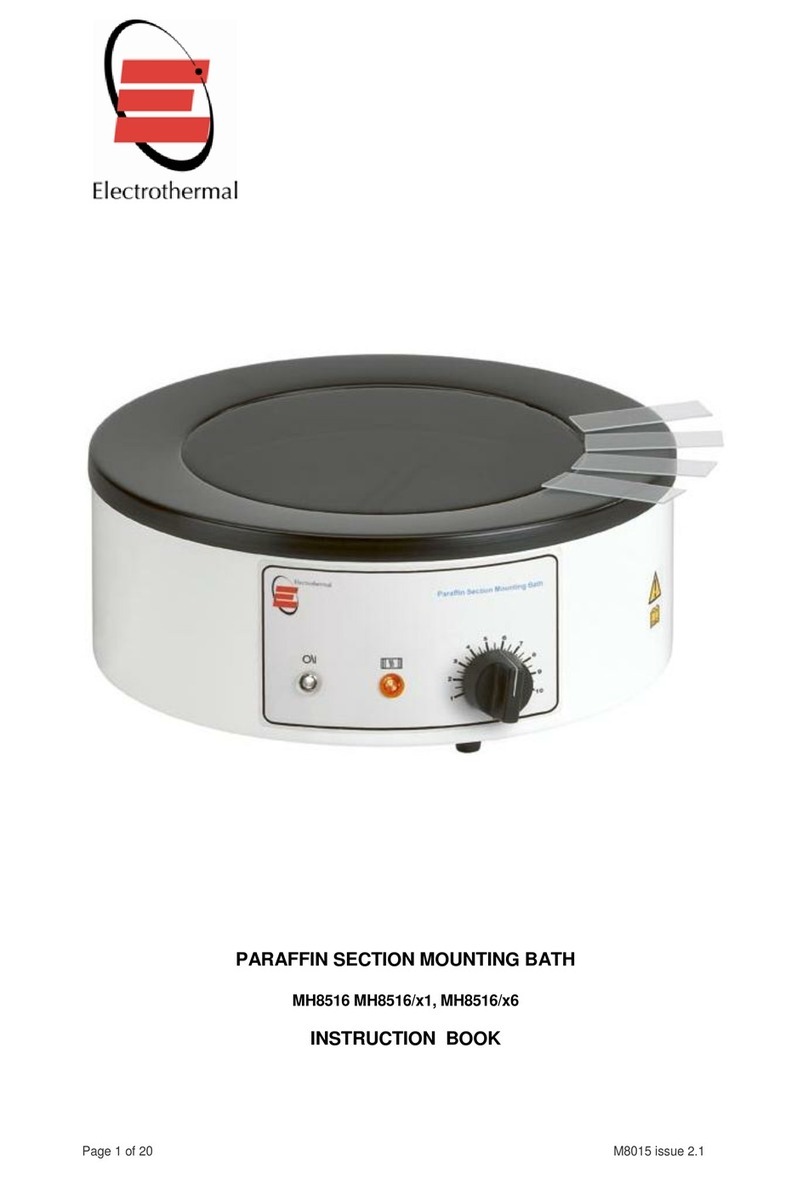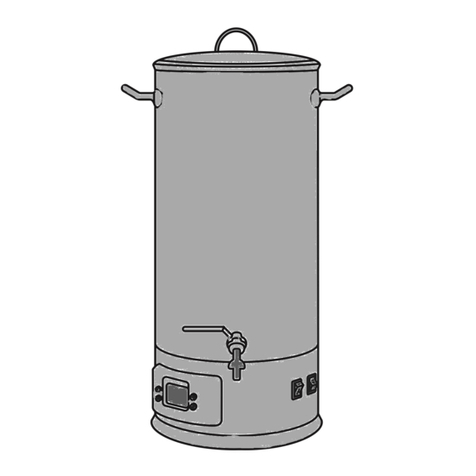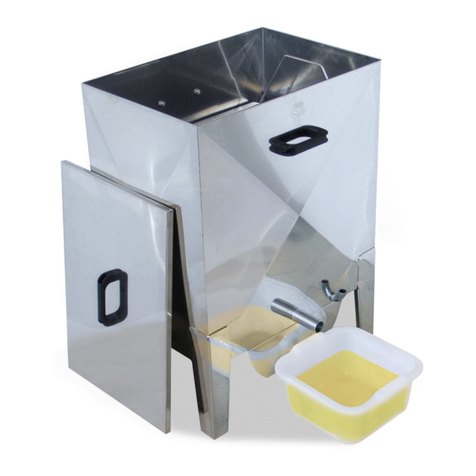CPMG Magma M4 Owner's manual

Melter Applicator
Owner/Operator Manual
2601 Niagara Lane · Plymouth, MN 55447 · (763) 557-1982 · (877) 841-0848 · Fax (763) 557-1971
Part # 161621 Rev B 1/20/17
Magma M4 Dual Pump

Table of Contents
Shipping Papers and Information....................................................... 3
Safety Notes......................................................................................... 4
Weights and Dimensions .................................................................... 5
Controls and Their Functions.......................................................... 6-7
Start Up ............................................................................................. 8-9
Automatic Temperature Control Setting .......................................... 10
Cleanout Procedure............................................................................11
Cleanout Procedure (Non-Electric Hose).................................... 12-13
Maintenance.................................................................................. 14-15
Fluid and Components Specs........................................................... 16
Heat Transfer Oil Specs..................................................................... 17
Material Tank Capacity ...................................................................... 18
Trouble Shooting Guide .................................................................... 19
Parts Section
Wiring Diagrams ........................................................................... 21-27
Complete Wiring Diagram............................................................. 21
Engine Harness............................................................................. 22
Control Panel............................................................................ 23-24
Main Supply Harness.................................................................... 25
Burner ............................................................................................ 26
Dual Heater Hose Relay Panel...................................................... 27
Dual Heated Hose control Panel .................................................. 28
Hydraulic Schematic ......................................................................... 29
Hydraulic Manifold Components ...................................................... 30
Hydraulic Schematic - Dual Pump Option ....................................... 31
Electrical Components...................................................................... 32
Engine Components..................................................................... 33-34
Material Plumbing Components .................................................. 35-36
Material Pump Parts List .............................................................. 37-38
Sealing Hose & Wand ........................................................................ 39
Sealing Wand Attachments............................................................... 40
Agitation System Parts List .............................................................. 41
Oil Burner Parts List.......................................................................... 42
Combustion Chamber Parts List and Tank Insulation .................... 43
Hydraulic Reservoir and Diesel Tank Components......................... 44
Misc. Parts.......................................................................................... 45
Spare Parts Kit................................................................................... 46

3
Shipping Papers and Information
A packet containing IMPORTANT INFORMATION has been enclosed with your Melter.
This packet contains:
1) Operation Instructions
2) Parts List
3) Warranty Information
4) Manufacturer's Documents
a) Engine
b) Material Pump
c) Burner (Diesel only)
IMPORTANT: This manual contains the basic information required to operate, main-
tain and repair the CIMLINE Melter you have purchased. The use of this manual in-
sures accurate adjustments, operation and proper lubrication of your equipment.
Please keep it handy.
Any parts orders or service problems relating to CIMLINE equipment should be di-
rected to the CIMLINE Parts Department at either (763) 557-1982 or (800) 328-3874.
When ordering parts, please have the following information available.
Serial Number: ____________________________
Model Number: ____________________________
Engine Model (H.P.): ____________________________
Engine Manufacturer: ____________________________
Pump Number: ____________________________
Replacement Part Number(s):

4
PLEASE READ AND UNDERSTAND ENTIRE OPERATORS MANUAL BEFORE
PROCEEDING
WARNING: Protective clothing must be worn. Refer to ANSI Regulations:
1) Wear gloves with wristlets.
2) Wear long sleeve shirt with sleeves rolled down and cuffs buttoned.
3) Wear a face shield.
4) Load Melter from ground level.
5) Keep material door closed at all times except when adding material.
6) Never stand on any part of the machine.
7) Do not pull, twist, stretch or kink the material hose.
8) Do not operate without safety cover on hose.
9) Do not touch exhaust stacks or mufflers.
10) Wear heavy leather boots or shoes.
11) Wear long pants with no cuffs.
WARNING: Do not over fill the melting tank. For best results, add only as much material
as required for the job or a maximum of 75% of tank capacity. (Model 410 -
308 gallons).
WARNING: On a new Melter applicator or a unit that has been idle for some time, slowly
raise the oil temperature to 250º F and hold there for approximately 20 to 30
minutes. This will help get rid of any condensation that may be in the oil
chamber.
WARNING: Never leave machine unattended while it is running.
Safety Notes

5
Model Number "A" in/cm "B" in/cm "C" in/cm Weight lbs/kg (empty)
410 89/226 188/478 93/236 5420/2458
Weights are without options
Weights and Dimensions

6
Controls and Their Functions
NOTE: This general outline will only familiarize you with the machine. Read through the
entire manual before putting this machine into operation.
1) Tank Outlet Valve: Allows melted material from the tank to flow into the pumping sys-
tem.
2) Access Port: The sealing wand is placed in here when not in use. This allows operator
to continue circulating material through the hose to prevent material from cooling and
freezing up.
3) Loading Doors: Place the material on safety door to load the melting tank.
4) Micropanel ignition Switch: Use the key to turn the engine on and off.
5) Wand Holder: On models with the electrically heated hose, the wand is placed into
this holder.
6) Material Temperature Gauge: Reads material temperature as it pumps through plumb-
ing system.
7) Pressure Valve: This valve controls the flow rate of the material being pumped to the
hose and sealing wand by changing the pressure setting. (Turning the valve clockwise
will increase the pressure which in turn will increase the flow). During sealing operations,
this valve alone can be used to regulate flow.
8) Sealing Hose Valve: Opening this valve will allow the material being pumped to flow
through the hose and sealing wand. The valve should be in the full "on" position during
operation to prevent flow restriction.
9) Control Panel: The main control panel is used to control the direction of the material
pump and agitator, and you can also monitor the temperature of the material and heat
transfer oil.
10) Pressure Gauge: This gauge measures the pressure required to turn the agitator. By
observing this gauge, the operator can tell if the agitator is rotating.
11) Cabinet Temperature Gauge: Indicates the temperature inside the cabinet. Do not
exceed 320º F (160º C).
12) Thermal Regulating Gate: Lift lever to open gate which will direct hot air to cabinet to
heat pump and plumbing.

7
Controls and Their Functions
1
2
3
4
5
6
7
8
9
10
11 12

8
1. SETUP:
A) Set Flow control to “9”
2. START ENGINE:
A) Turn key on engine control to “1”
B) Heat glow plugs 3-5 seconds.
C) Turn key to “2”
D) Release when engine starts
3. OPEN PRESSURE VALVE
Turn pressure valve counter clockwise
all the way open.
Start up
B) Set rotary switch to RUN

9
4. WAND
A) Unlock Boom
B) Place wand in port.
5. Ready for Work
When all 3 GREEN lights are on:
A) Set Flow to “0” B) Pin Wand trigger
and set handle forward
C) Set Flow to “5”
Start up
D) Close pressure valve to
desired material flow level.
E) Start Sealing

10
Automatic Temperature Control Setting
Loading Empty Tank
All material must be clean. Keep all foreign matter out of melting tank.
1) Open the material door (1) and place slab or biscuit (2) on the open door against the
holder (3).
1
2
3
The control system on your CIMLINE “M” series melter has been factory set to run the most
common types of materials. These Materials have an application temperature of 380 deg F.
With some materials, it may be needed to change the controller to achieve the appropriate appli-
cation temperature. To achieve this, open the control box and alter the material controller (top
controller) by following the directions below.
Increase (UP)
Decrease (DOWN) (A)
1) Press the SET button.
2) SP1 is displayed.
3) Press the SET button.
4) Current Temperature is displayed.
5) Use the arrow buttons to change to the desired temperature.
6) Press the SET button.
7) Let the controller time out. Your controller will now be change and the updates will
be saved.

11
Cleanout Procedure
1. SETUP:
A) Place wand in port.
B) Pin wand trigger and set handle for-
ward.
C) Set rotary switch to “CLEAN OUT”
D) Set flow to “9”
Hose Clean-out:
Let pump run in reverse for 2 minutes.
Pump Clean-out:
Unpin wand trigger.
Turn pressure valve all the way counter-clockwise
Continue running pump in reverse for 2 minutes.
Shut down:
Shut Engine off by turning key to “0”
Set Rotary switch to “OFF”
Move Boom to travel position and lock.
Store wand
E) Turn pressure valve all
the way clock wise

12
Regardless of how you store your hose, the residue tends to settle at the bottom of
the coils overnight. Each day when the unit is started, the hose must be coiled up
and placed in the cabinet during the preheating process, as shown in the picture be-
low. Unless the hose was cleaned with compressed air, you will probably have
enough material remaining in the hose to require this procedure.
NOTE: Once the Melter is up to operating temperature, the burner typically
does not cycle often enough to get the cabinet to the required temper-
ature to unplug the hose.
On cold and windy days, it is very important to maintain material flow through the
hose at all times. This requires keeping the material up to temperature and return-
ing the wand to the access port anytime the wand will be shut off for more than 30
seconds to a minute. If the hose plugs during sealing operations, one of the follow-
ing procedures should be followed:
1) Immediately remove the sealing tip (if you are using one) and insert the
wand into the
access port. With the sealing hose valve and the wand valve both wide open,
turn the
pressure valve clockwise to increase the pressure supplied to the hose. Do
this until
the engine almost stalls. If this does not work, proceed to another method.
Cleanout Procedure (Non-Electric Hose)

13
NOTE: Immediately coil the hose inside the cabinet.
2) If the unit is not full of material, add material to lower the tank temperature
enough so the control box will fire the burner. Keep adding material until
the cabinet temperature is high enough to unplug the hose.
NOTE: Be sure to open the thermal regulating gate to the full open position.
On propane units, be sure the stack diverter is closed.
3) If the unit is full, it may be necessary to open up the loading door and allow the
material to cool down. Turn the temperature control setting to 250º F (121ºC).
Allow the material to cool down enough so that the burner will have to run for a
period of time long enough to heat the hose sufficiently. The actual time
required will vary depending on how much material and what type of material is
left in the hose. Thermal regulating gate must be wide open. On propane
units, the stack diverter must be closed.
4) If the unit is clogged and the above two procedures are not possible, it may be
necessary to use a back up hose. The clogged hose can then be connected
and unplugged the next time you start up with a cold material tank.
The above situations illustrate the importance of properly cleaning the hose after use.
It also shows the importance of returning the hose to the access port during times be-
tween use to keep the material flowing freely through the hose.
Cleanout Procedure (Non-Electric Hose)

14
Engine: The operation and life of the engine depends on you and your operator. Do not start
engine until the engine precheck is complete. The engine precheck consists of checking the oil,
the fuel level, the hydraulic oil level and the air filter. The 150/230/410 M/A has the option of (2)
different engines. The Isuzu 22.8 H.P. and 40.3 diesel units. For more detailed information
please refer to the Engine Operator Maintenance Manual and Warranty provided with your Melt-
er applicator.
NOTE: When breaking in a new Melter, we recommend running the engine for one
hour with no load prior to actual use on the job.
Air cleaner: Due to the dusty conditions that can be created by road work, it is essential to
check the engine air cleaner element daily. Remove element and shake out the accumulated
dust and dirt. Wipe out dirt from inside cover and from housing. Check engine manual for
washing instructions. We recommend stocking replacement filters.
Diesel Units: Use of high quality detergent oil of API (American Petroleum Institute) service
class CC or CD grade. Select the viscosity based on the air temperature at the
time of operation. Check your engine manual for other recommendations.
Burner: There are several items that need to be inspected periodically on the burners. These
items include the burner nozzle, electrode and head position, chamber lining (see below) and
the electric eye. Please refer to the burner manual on how to perform each of these operations
in this manual..
After each 200 hours of operation, the chamber lining should be inspected. Remove (8) burner
mount securing bolts (A) and pull out burner and mount. Inspect lining (B) for excessive crack-
ing. Also check the condition of retainer (C). Lining cracks are acceptable as long as they are
not large enough to allow flame to contact the combustion chamber walls.
(A)
(B)
(C)
Maintenance

15
Maintenance Operation Daily 25 Hrs 100
Hrs 200
Hrs 1000
Hrs Yearly
Check fuel level (add if low) X
Check engine and heat transfer oil (add if low) X
Check hydraulic oil (add if low) X
Check engine air cleaner X
Inspect pre-cleaner X
Cleanout material system X
Inspect sealing hose and cover X
Inspect sealing hose connection X
Drain condensation from air compressor option X
Blow oil cooler on the air compressor option X
Inspect and clean cooling system (Diesel units only X
Inspect material pump packing (adjust if leaking is excessive) X
Check oil level on air compressor option X
Service air cleaner element X
Inspect spark plugs and breaker pts. (Propane units only) X
Inspect burner motor brushes (replace if worn out X
Inspect burner nozzle, electrode & head pos. (adjust if nec.) X
Change engine oil and oil filter X
Grease agitator bearing block (load adapter) X
Inspect fuel filter (replace if dirty) X
Inspect Diesel burner electric eye (clean if dirty) X
Grease wheel bearings X
Inspect chamber lining (replace if excessive cracking) X
Change oil on compressor option X
Change air inlet filter on compressor option X
Inspect starting motor X
Replace hydraulic oil X
Replace hydraulic return filter X
Replace hydraulic suction strainer X
Replace burner nozzle X
Change heat transfer oil X
Change Diesel fuel filter X
Flush radiator and replace fluid (Diesel units only) X
Replace separator on air compressor X
Maintenance

16
Fluid and Components Specifications
WARNING: Only the oil specified or equal may be used in this system. (Always check
your local and state regulations before disposal).
NOTE: A dipstick (A) is provided for checking oil level when cold.
*This is a petroleum based product, it can be mixed with other petroleum based hydraulic oils
such as Dextron III or common straight weight oils. We recommend that you do not mix oil
brands. Mixing any oils (engine oil, transmission fluid, etc.) adversely affects each manufacturers
formula.
COLD OIL LEVEL
M4
Hydraulic Reserve Capacity 30 Gallons
Hydraulic Oil Type Conoco MV32 or equiv
Diesel Fuel Capacity 30 Gallons
Diesel Fuel Type ASTM D975 No.2
Heat Transfer Oil Capacity 36 Gal.
Heat Transfer Oil Type See Specs. On next page.
Agitation Drive Relief Setting 800
Material Pump Drive Relief Setting 800
Material Pump Displacement .11 Gal/Rev
Material Pump Maximum Output
Pressure 125 PSI

17
Heat Transfer Oil Specifications
ISO Grade 68 Heat transfer Oil Specification
There are many different types of Heat Transfer Oils on the international marketplace. It is criti-
cal that you use the proper oil to prevent poor performance, oil flashing, or auto-ignition. To
conform to most government bids and to supply a readily available product, CIMLINE typically
uses brands manufactured by Conoco or Phillips 66 that meet the ISO Grade 68 Heat Transfer
Oil specifications listed. To insure maximum safety and performance, we recommend you pur-
chase your oil through CIMLINE.
ISO VG# 68
Pour Point - F 10º F (12º C)
Flash Point - F 485º F (252º C)
Lbs/Gallon 7.27
Viscosity CsT @ 40C 62
IMPORTANT NOTICE!!
The ISO Grade is just a viscosity index (ability to flow/thickness). An ISO Grade 68 oil can be
an engine oil, hydraulic oil, etc. The manufacturer uses different additives to make the oil con-
form to different applications. YOU MUST CLARIFY with the supplier that the oil is to be used
in a heat transfer system to avoid any potential problems. Oil is also available from CIMLINE in
5 and 30 Gallon containers for ship-out.
NOTE: CIMLINE Melter/Applicators include and expansion tank that cools the oil that is ex-
posed to the outside air. When the oil heats up and expands, it flows into the expansion tank.
The tank is cooler since it is not oil jacketed and is surrounded by outside airflow. The only ex-
posure the hot oil has to the atmosphere is through a 3/4" vent/overflow pipe. This is done so
the oil in the tank can run higher than the flash point. Only the lower temperature oil fumes are
exposed to the atmosphere.
FLASH POINT - Test in which an open container of oil is heated until an open flame will flash
when passed over the fumes.
FIRE POINT - Same test as the flash point except the oil is heated until the gasses will start a
fire.
AUTO IGNITION POINT - The point at which fumes will burst into flame when exposed to air.

18
MATERIAL CAPACITY
Gallons of material is found by first dividing the tank volume by 231 (# of cubic inches
per gallon of liquid), and then multiplying that number by the number of inches of mate-
rial in the tank. For example, 1052 divided by 231 = 4.55. 4.55 x 2" of material = 9.11.
* Volume of tank in cubic inches for each inch of material.
MATERIAL VAT MODEL 410
13.9 GALLONS
PER INCH
INSULATION
AIR
OIL
Material
Depth
Model 410
3210 Cubic
Inches
2" 27.79
4" 55.58
6" 83.38
8" 111.17
10" 138.96
12" 166.75
14" 194.55
16" 222.34
18" 250.13
20" 277.92
22" 305.71
24" 333.5
26" 361.3
28" 389.09
Material Tank Capacity

19
MODEL 410
13.9 GALLONS
PER INCH
Problem Cause Solution
Burner will not ignite
Fuse burned out. Check fuse
Burner relay inoperative. Check for 12VDC at relay.
Primary control fuse. Check fuse
Thermocouple(s) inoperative Replace thermocouple(s)
Agitator will not rotate
Fuse burned out. Check fuse
Sealant material not hot enough. Allow material to heat longer
Too many biscuits added at one
time. Continue heat up and reverse agitation
to break biscuits free.
Low hydraulic oil level. Check oil Level
Worn agitator motor. Replace Motor
Material pump will not ro-
tate
Fuse burned out. Check fuse
Sealant material not hot enough. Allow material to heat longer
Too much material left in lines Heat plumbing and valve to melt material
Low hydraulic level Check oil level
Foreign object lodged in line Remove foreign object
Pump damaged Repair or replace pump
Material pump rotates but
does not pump material
Pump worn or damaged Repair or replace pump
Pump rotating in wrong direction Reverse pump switch
Pump inlet line plugged
Check matl tank grid and lines for ob-
struction
Too much material left in lines
from previous use. Heat plumbing and valve to melt material
Material heat up time slow
Burner orifice clogged Remove orifice and clean
Heat transfer oil is worn out Check oil level. Replace if necessary
Too much old material on tank Clean material tank
Material recirculates but
will not flow through seal-
ing wand.
Sealing hose valve not completely
closing or worn out Realign valve or replace
Actuator not turning valve
Check Fuse
Check trigger switch
Broken or disconnected wire in the elec-
tric hose or at the switch
Trouble Shooting Guide

20
Parts Section
Table of contents
Other CPMG Melting Machine manuals
